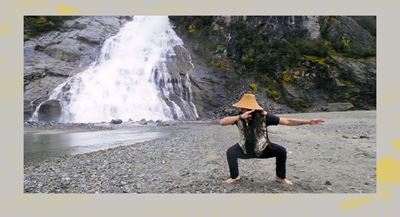
The UArctic Thematic Network on Arctic Sustainable Arts and Design (ASAD) has actively shared experiences and examples of art engaged with Arctic issues, not only among universities but also outside them. In November 2022 such an event took place in Finland in Levi, where Finland’s national public broadcasting company YLE organized the Aurora Future Event, a summit where experts and policy makers discussed climate change.
By Timo Jokela, Lead of the UArctic Thematic Network on Arctic Sustainable Arts and Design, UArctic Chair in Arctic Art, Design and Culture, Professor, University of Lapland and Maya Salganek, Filmmaker, Associate Professor, University of Alaska Fairbanks
The Arcta Fast project coordinated by the University of Lapland produced a diverse art program for the event. The circumpolar cooperation of the ASAD network got visibility through young people's short films and video installations from Finland and Alaska that were shown as part of the program.
The video installation Minun Paikkani – Mun Baiki - My Place made by young people from Finland was on display on a huge outdoor screen. Through photos, videos, and text, the installation told about the youth's favorite places and what they would like to keep in them. The installation coordinated by PhD students Korinna Korsström-Magga and Aki Lintumäki was part of the Kone Foundation funded art-based project On the Frontline of Climate Change which examines the importance of art in dealing with the young people’s climate anxiety. The presence of nature in art activities opens up thoughts, insights, and discussion on values, and art as a medium creates the means for participating in social discussion.
The second entity on display, Stories for Climate Justice, came from the University of Alaska Fairbanks in conjuction with Native Movement, a non-profit focusing on grassroots mobilization rooted in decolonization. Produced during the inaugural Alaska Native Filmmakers Intensive, Stories for Climate Justice presented a selection of films by Indigenous filmmakers examining how they witness and respond to the impacts of climate change on their homelands and communities. Each filmmaker examined the interconnection between their own personal histories, issues impacting their communities, and generational connections to place as they reflected on their relationship with the lands and waters of Alaska.
Indigenous filmmakers practice narrative sovereignty when they tell their own stories rooted in cultural knowledge, and often directly to their own communities. By centering Indigenous voices and concerns, more-than-human kinship, and intergenerational knowledge shared through oral history, these films present an alternative to dominant narratives of climate change typically shown in mainstream media.
It is essential that young people in the Arctic, especially in Indigenous communities, have platforms to share the impacts of climate change on their cultures, communities, and lands. These cinematic presentations are reflections of the efforts across the Arctic to recenter our understanding of - and fight against - the climate crisis through narrative stories of love of place and connection to the land.